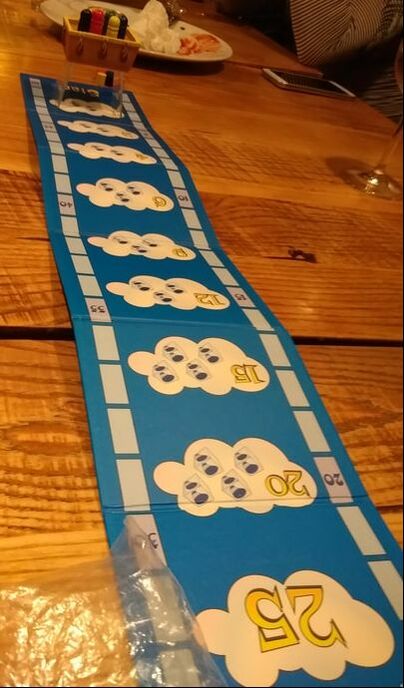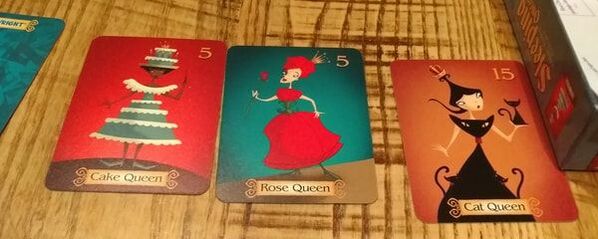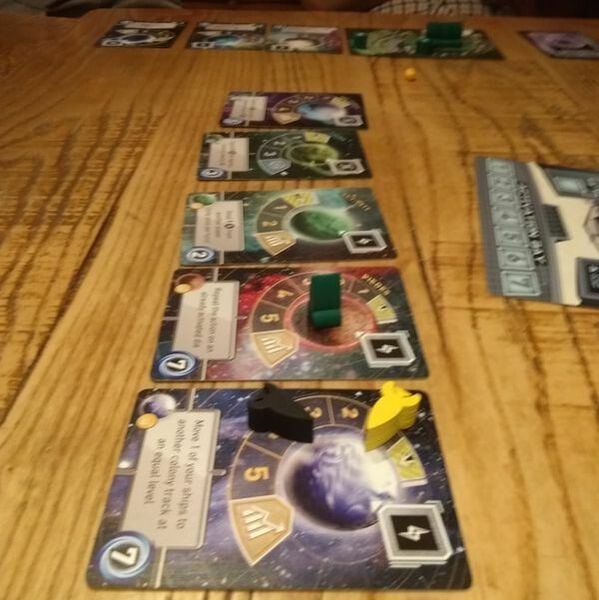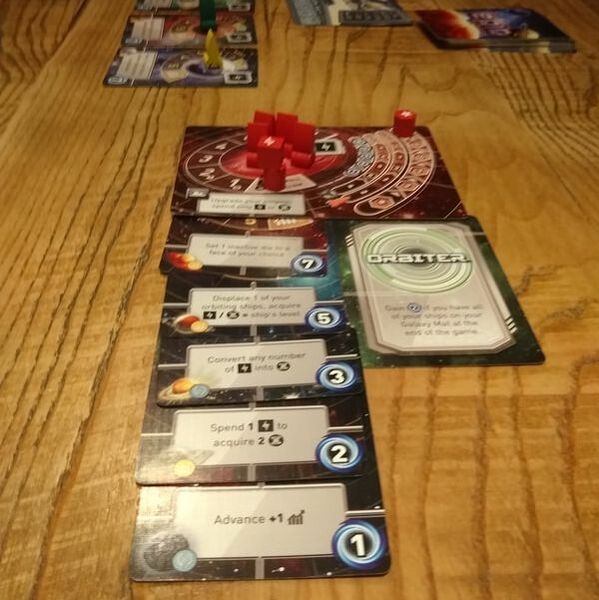|
5th March 2019
The final game of the night at 'The Sovereigns). Game 3 was 'The Great Dalmuti'. The Great Dalmuti is a card game designed by Richard Garfield - he who invented 'Magic: The Gathering'. In fact, The Great Dalmuti was the first game Richard Garfield designed after Magic - and it was another card game! There was a lot of speculation about what this game could be? It turned out that it was a 'normal' card game. It also turned out that it is a good card game. The Great Dalmuti is a trick-laying card game with a little twist: It's all about social inequality. At the start of every game a social hierarchy is established (either by cutting the deck or the finishing order in the previous game). The social order goes like: Greater Dalmuti: Sitting at the top of the heap is The Greater Dalmuti. Lesser Dalmuti: Next is the Lesser Dalmuti, lower than Greater Dalmuti, but higher than the Merchant classes. He know his place - much like the Two Ronnies sketch. Merchants: There can be up to 4 Merchants in a game, they are also arranged according to the social hierarchy. Lesser Peon: The Lesser Peon is not quite bottom of the heap, that is reserved for... Greater Peon: The Greater Peon, who truly is at the bottom. Even worse; the Greater Peon must shuffle and deal cards out at the start of the game. Once the social order has been established, players must change seats according to their position in the hierarchy. The Greater Dalmuti doesn't have to move (and why should he, he's the most important player in the game). So The Lesser Dalmuti sits to the left of The Greater Dalmuti. To the left of The Lesser Dalmuti sit the Merchants, starting with the most important merchant and going downwards in order to the left. To the left of the lowest merchant sits The Lesser Peon and finally to the left of The Lesser Peon sits The Greater Peon. Interestingly, this means that The Greater Dalmuti is to the left of the Greater Peon and that they sit next to each other. Next, the rules need to be explained before talking about how the game's twist affects the gameplay. The deck of cards consists of 80 cards.
The goal is to empty your hand of cards. This is done by playing 'tricks'. Whoever is The Greater Dalmuti begins the first round of the game. In subsequent rounds, whoever last played a trick begins the round.
So that's the rules, what about the twist? What about the social inequality? That's where taxation comes in. What's taxation?
However, during taxation, there is a small chance of something called revolution. This is how revolution works.
And that's the rules, with a small twist of inequality thrown in for good measure. This inequality makes for some interesting asymmetrical game play. When playing, what tends to happen is that the players at the higher end of the hierarchy tend to dominate the first few rounds, (quite often, by the time play reaches the lower positioned players, they have to pass) this allows the higher ranked players to dominate. But usually, at some point the Peons will get to start a round; then they tend to steamroller everyone else for a while. When a Peon player decides to lay (as their first trick) something like 7 12s, it's likely that The Greater Dalmuti player won't even have 7 cards in their hand, nevermind 7 cards that match! Whilst the lower value cards are better, sometimes they cannot match the number of higher numbered cards that are played. Like all good games, your decisions here are very important. Sometimes you have to resist the urge to always just get rid of your worst cards (very often a sound strategy) to retain a set or keep a good card for later. EG; do you break a set of 3 cards to play a trick now or retain them, so that later they can be used make a trick harder to trump. Being able to 'control' when a trick ends, so that you get to determine the cards that start the next trick is very useful. The Great Dalmuti is a quick and easy game that is fun to play and I only have 2 minor gripes about the game.
Other than that, it's nice little game.
0 Comments
5th March 2019.
The 2nd game of the night at Woking Boardgames Club at 'The Sovereigns' was Loot. I've played Loot previously and you can find a more detail report about here. 5th March 2019 It was gaming Tuesday at 'The Sovereigns' in Woking. It was also a night of playing several small games instead of one long one. We kicked off with 'Cloud 9', a sweet (both literally and figuratively) little push your luck board game. The premise of the game is that all the players are passengers/pilots in hot air balloon. The higher you go, the more points you score. How is it played. The first thing to do is set up the board: The game board is long and thin, it depicts a column of clouds, dice and scores are depicted in every cloud cloud and the scoring track runs along the outside. Unusually it appears to made be of vinyl and smells suspiciously like being in old car! The game also has a nice looking little model to represent the wicker basket. The basket has 6 spaces to hold up to 6 meeples (Cloud 9 supports up to 6 players). When all the meeples required at placed into the basket, the basket is placed on to the lowest cloud on the board. The game's custom 'Cloud 9' dice are 6-sided dice. However 4 sides on each die shows 1 of the 4 different colours. The remaining 2 sides are blank. There are 4 Cloud 9 dice, these are placed into the playing area One player is assigned to be 'The Pilot' at the start of the game. Cards are then dealt out to all players. The remaining cards form a draw pile. There are 2 types of card:
The rules are basically quite simple:
How are the dice matched by the pilot's cards.
Talking of points, when a player earns 50+ points it triggers the end game. This means that the current trip continues until it ends (or crashes) and all final points from the trip are added: The player with the most points, wins! And that's it for rules. There are some rules for what happens if only the pilot is in the balloon when it rises, but it's not really necessary to talk about them here, you get the gist of the game. As a game it's simple to learn, it's a good introduction game for people who haven't played that many board games. But it has some depth too. You need to think about how many cards the pilot has before making a choice to stay or jump. you can even try to remember what they did in a previous turn. EG, if they could not match a dice roll that included red and their current dice roll includes red, have they managed to pick up a red card from the draw deck? Also; you need to remember if any wild cards have been played and by whom (there's 4 wild cards in the deck). Another thing to remember is that when you're the pilot, you cannot jump out (unless you're alone in the basket). This means that you have to roll the dice even if your hand is empty! Well each die has 1/3 chance of coming up blank... Finally, Cloud 9 has a curious element of co-operative play. It's actually hard to get to the higher clouds alone and you must work with other players to do it. Quite often after a couple of players have jumped, the remaining players will suddenly starting playing those wild cards to try and push it further - excluding the early jumpers from extra points. Cloud 9 is a nice push-your-luck game that is a good starter or finisher game that plays with up to 6 players. 2nd March and the 2nd game of the night at Matakishi's beckons. Sleeping Queens is a little card game. It was invention of a 6 year old girl trying to get to sleep one night that became Sleeping Queens. The game consists of a deck of cards and a number of 'Queen' cards. Sleeping Queens is won by collecting queen cards. Each queen card is worth a number of points and the game is won when a player reaches the point limit (which differs according to the number of players). Set up The queen cards are all spread out face down in the gaming area. 5 cards from the deck are randomly dealt to each player. Player proceeds clockwise and each player gets to play 1 card or discard. There are 7 types of cards:
There are a couple of other rules, but that's the gist of the game. Sleeping Queens is a light game and definitely skews towards younger players, especially with the slightly educational nature of discarding number cards. But it also has a quick set up and quick play time. Making it a pleasant little filler game or something to end the evening with - especially if you've spent the last couple of hours on some brain-melting strategy game! One last thing worth mentioning is the art direction. All the artwork is genuinely whimsical, as is the naming of the kings and queens such as Ladybug Queen, Doughnut King, Rainbow Queen etc. It lends the game a I guess sort of appealing timeless quality.
2nd March.
Another evening of gaming at Matakishi's place. We started evening with a firm favourite; Port Royal This is the 3rd time I've played it this year. 26th February 2nd game of the night at 'The Sovs'. Tiny Epic Galaxies is a part of the 'Tiny Epic' line of games from Gamelyn. I guess that all of these games aim to deliver epic gameplay in a tiny box? Does Tiny Epic Galaxies deliver on this? See below. Well, it comes in a tiny-ish box, so that's a good start. Tiny Epic Galaxies is a card and dice game that combines elements of worker placement with push your luck to make a game about galactic exploration and expansion. Infact exploration and expansion are how you earn nearly all your victory points - and of course, the highest victory points wins the games. Set up To start with, each player is given their own 'galaxy mat'. The galaxy mat is used to track 3 scores. Energy, culture & galactic level (all explained below). Next, each player is given 2 secret mission cards, they then choose one to keep hidden face down next to or under their galaxy matt. The unused card is discarded. Then planet cards are dealt face up in a line. These represent newly discovered planet that players can exploit or colonise. Planet cards are explained in detail below, but it's worth noting here that there are always more planets available than players (by 1 or 2). Finally the control mat and the dice are placed where everyone can reach them. How to play Very simply: You roll the dice and then carry out the actions displayed on the dice. I think it's simpler to explain what some things do, then how play goes. Let's start with the galaxy mat.
Planets There are a number of features on every planet, all of them important.
Control mat
Dice rolling
When rolling the dice, player's will roll 4-7 dice (dependent on the level of their galaxy), all the dice are identical and have 6 different symbols. These are:
Rerolling dice After rolling their dice, the player can choose to re-roll some or all of the dice they just rolled. A player can choose to re-roll 2 or more times, but each additional re-roll after the first will cost a point of energy. There you have it, more or less all the rules. Play continues until a player's victory points reaches 21 or higher, this triggers the end game. Play then continues until all players have had an equal number of turns and then points are totted up. At this time players reveal their secret missions, if the objective is met, the the points are added to the player's total. Secret missions tend to add 2-3 victory points to the total, which is about 10-15%, so not insubstantial. I've played Tiny Epic Galaxies several times now and I always enjoy it. There are 40 different planet cards and they always appear randomly. I've found that quite often judicious use of their special abilities can give you an edge. So you need to pay attention to which ones appear, they're more than just victory points and resource generators. Add to this the unpredictability of the dice and you have a game with a lot of genuine replayability. There is one thing I will mention and that is the potential of the 'culture generation' strategy. If you have at least 2 ships on planets that generate culture and keep at least a point of culture on your galaxy mat: Anytime another player activates a culture die, you can spend a culture die to follow them - and generate 2 culture, giving you a net gain of 1 culture at no outlay (other than the initial point of culture). You can do this as often as you want whenever someone else activates a culture die with absolutely no drawback. Now this does requires a particular set of circumstances to occur, but they are not too uncommon (we encountered it the 1st or 2nd time we played it entirely by accident): I'm not sure if it's overpowered or not. It feels like it straddles the line between genuine strategy and exploit so I'm not too certain whether it's a legitimate criticism or not. Ah well. Despite that potential issue, I think it's still a good game to play. Is it epic? Well it's certainly good, although Tiny Good Galaxies' probably doesn't have the same ring to it! 24th February The day after Gameblast 2019, phew! We began on our skiff in 'Bubbly Bay' (should never have let Win name the bay). The black sand beach is composed of eroded volcanic rock. Talking of Win, she used her gliding talent to land on the beach, immediately nearly half a dozen giant crab-things emerged from the black sands and attacked! We managed to defeat the them without too much trouble, we restocked our food supplies with crab meat. Then after disembarking on to the black beach, we saw that it backed on to a sheer cliff face. We found a hidden path that rises up and along the cliff face. Day 1 We followed the ascending path, it was slow work and took 6 hours, eventually we arrived at a plateau. We spent the night in a 'depression'. However, during the hours of darkness, swarms of flying things (we later learned are called razorbills) attack us. We struggled with the swarms for a while, but in the end they were driven away. Day 2 We continue our journey to the volcano. Pushing on throughout day 2 we entered a jungle. The heat was sweltering and encountered more swarms - this time swarms of mosquitoes that mercilessly bit at us. Later in the day, Backstab Baxter stumbled across a diamond! Later on in the day we discovered a 2nd diamond. It seems something weird about the volcanic region can produce diamonds as a byproduct. Day 3 We continued inland through the jungle. During the day, we heard voices ahead through the jungle. Cautiously we searched ahead. We spotted a band of shaggy red-men passing through along a jungle trail. We stayed back and they did not spot us and moved on. We decided that it was best to avoid red-man, let them go on their own way and did not take the trail and continued through the jungle. Later on in the day we spotted a second band of red-men; they were close to a river. We stopped and observed them. They appeared to be performing a ritual that eventually involved sacrificing a red-man into the river. We surmised that there was something in the river that the red-men were making a sacrifice to. We decided to be very cautious very cautious around that river. Once again we thought it good to avoid the red-men and pressed onwards towards the volcano. By the end of the day, we were at what we considered the base of the volcano. |
AuthorI play, I paint. Archives
March 2024
Categories
All
|





 RSS Feed
RSS Feed
